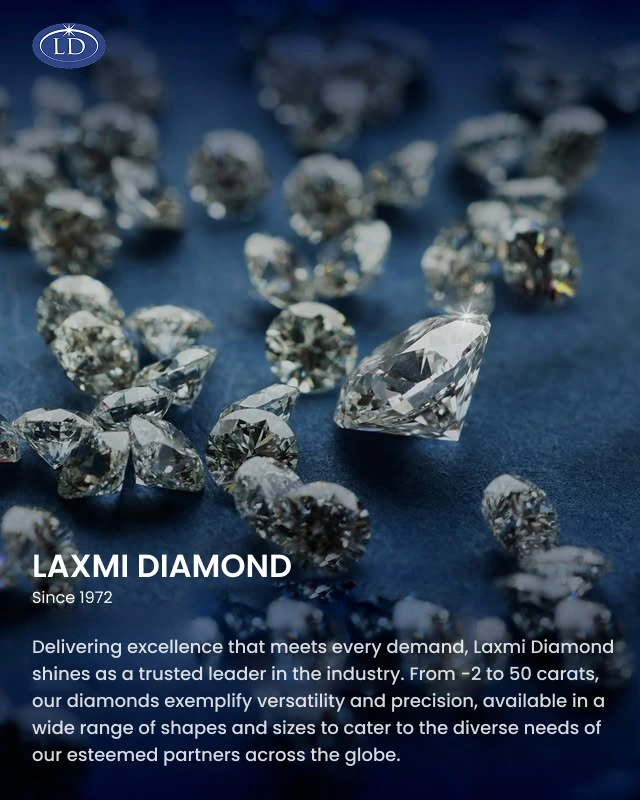
Angles in Harmony: How angles enhance the sparkle of your diamond
Angles play a pivotal role in the world of diamonds, as they directly influence a diamond's brilliance, sparkle, and overall visual appeal. The precise angles at which light enters and exits a diamond are crucial in determining its optical performance. The crown and pavilion angles, in particular, dictate how efficiently light is reflected within the diamond and subsequently returned to the observer's eye. When these angles are optimized, they create a dazzling display of fire, scintillation, and brilliance, making the diamond truly radiant. Thus, understanding and controlling angles during the cutting and shaping process are essential for diamond artisans to unlock the full potential of each precious gem, ensuring that it shines as brightly as possible, and captivates the beholder with its beauty and brilliance.

Understanding diamond facets and angles
Understanding diamond facets and angles is essential for anyone who appreciates the brilliance and beauty of these precious gemstones. Facets are the flat, polished surfaces on a diamond, and they play a crucial role in how light interacts with the stone. Each facet is carefully cut and positioned to maximize the diamond's ability to reflect and refract light, creating the stunning sparkle that diamonds are known for. The precise arrangement and angles of these facets determine the diamond's overall appearance and visual appeal.
Diamond angles, such as the crown angle and pavilion angle are critical in controlling the diamond's light performance. The crown angle affects the amount of light that enters the diamond, while the pavilion angle influences how light is reflected back to the viewer's eye. When these angles are cut to precise measurements, they create a perfect balance of brilliance (white light) and fire (coloured light), resulting in a diamond that exhibits a dazzling play of light. Understanding these facets and angles empowers consumers to make informed choices when selecting diamonds, ensuring they choose stones that meet their desired level of sparkle and brilliance. It also deepens the appreciation of the craftsmanship and artistry that goes into creating these remarkable gems.
Optimal light and reflection
In the world of diamonds, the interplay of light and reflection is nothing short of magical. At the heart of a diamond's brilliance lies its ability to interact with light in the most exquisite manner. Optimal light performance in a diamond is a result of precise craftsmanship and the diamond's inherent properties. When a diamond is cut to ideal proportions, light enters through the table facet, slowing down and bending as it moves through the diamond. This bending of light, known as refraction, causes it to separate into its spectral colours, creating the mesmerizing rainbow-like flashes of colour known as "fire."

However, it is not just refraction that defines a diamond's beauty; reflection is equally crucial. The facets of a well-cut diamond act as tiny mirrors, strategically placed to reflect light back towards the observer's eye. This reflection creates the dazzling brightness, or "brilliance," of a diamond. Achieving the perfect balance between refraction and reflection is an art form, and it's what transforms a rough diamond into a scintillating gem. In essence, it is the precise alignment of angles and facets that allows a diamond to reveal its full spectrum of fire, brilliance, and scintillation, making it a timeless symbol of beauty and elegance.
The Role of the Crown Angle
The crown angle is a critical factor in the evaluation of a diamond's cut quality, playing a pivotal role in determining the stone's overall brilliance and visual appeal. Situated between the girdle (the diamond's widest part) and the table (the flat top surface), the crown angle represents the angle at which the facets on the upper portion of the diamond are cut in relation to the girdle. An optimal crown angle ensures that light entering the diamond is refracted and reflected within the stone, ultimately producing the coveted fire, brilliance, and scintillation that make diamonds so captivating.

A well-balanced crown angle neither allows too much light to escape through the sides of the diamond nor traps it within, striking the ideal equilibrium for maximum sparkle. When the crown angle is too shallow, light exits prematurely, resulting in a loss of brilliance. Conversely, if the crown angle is too steep, light may be excessively reflected internally, causing a lack of contrast and an overly dark appearance. Thus, the crown angle, in conjunction with other cut factors, such as pavilion angle and table size, plays a vital role in achieving the diamond's full potential for radiance and beauty.
Laxmi Diamond's Technology for Diamond Cutting
As technology takes centre stage in the diamond industry, Laxmi Diamond embraces cutting-edge machinery, including rough diamond scanning, laser cutting, and polishing equipment. These innovations not only enhance efficiency but also empower us to uphold unparalleled precision and accuracy in the art of diamond cutting and polishing.

Laxmi Diamond uses advanced equipment such as the Sarine Galaxy Machine, Diamond marking machine, Diamond laser cutting machine, Diamond marking machine, Diamond bruting machine, and Diamond grading microscope to ensure accurate cutting of the diamond.
How Laxmi Diamond makes sure that the angle is perfect
A perfect angle is imperative for a diamond to achieve its utmost brilliance. At Laxmi Diamond, we employ a dual approach to ensure the highest diamond quality. Firstly, we invest in extensive artisan training, enabling them to master their craft. They meticulously cut each stone to perfection, ensuring the ideal angles for maximum shine.
Secondly, we harness cutting-edge technology that assists our artisans in achieving precise cutting measurements, further enhancing the brilliance and precision of our diamonds. It also helps keep the quality of the diamonds persistent throughout the production chain and speeds up the process. Our cutting-edge technology and highly skilled artisans are the perfect combination that shapes our diamond in the angles of perfection.








